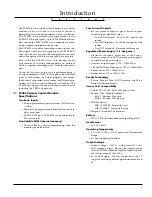
6
Programming of the PC4820 is performed at the PC4010/
4020 control panel in Installer’s Programming mode.
Refer to Section 4 “How to Program” of the PC4010/4020
Installation Manual for instructions.
The following programming sections must be
programmed for each PC4820 enrolled on the system. To
select a module, enter reference number [0011XX] where
“XX” refers to the PC4820 module number.
The control panel will transfer all necessary information
(access codes, scheduling, etc.) to each PC4820 module
whenever one of the following occurs:
1. the main panel is powered up
2. installer’s mode is exited
3. a PC4820 loses and then restores communication
with the control panel
4. a PC4820 is hardware defaulted
5. a PC4820 is enrolled
6. a downloading session has disconnected.
The data transfer can take up to 2.5 minutes per PC4820
module. When the transfer is completed, all keypads will
beep 16 times. Changes to PC4820 programming will not
take effect until the data transfer is complete.
3.1 Programming Reader Types
Ref # [0011XX00] where XX = PC4820 module #
The PC4820 is capable of supporting different types of access
card readers. The same type of reader must be used on both
doors of an access card module, but different modules may
use different reader types. Enter the 2-digit code for the
reader type you are installing on the selected zone.
00
Polaris 1- Magnetic card reader. 7 Digits with clock
and data.
01
Shadow Prox - Extended range proximity reader
SH5, SH6, SH7, SH-VR 32 Bits.
02
26 Bit Standard Wiegand reader, HID Proximity
readers
The default access card reader type is
00
(Polaris 1).
3.2 Reader Options
Ref # [0011XX01] where XX = module #
This section contains the programming for the selected
PC4820. First, you must select which of the two doors to
program. Use the arrow (< >) keys to scroll to either Door
1 or Door 2 and press the [*] key to select. A series of toggle
options will be available for each door. Again, use the
arrow (< >) keys to scroll through each option and press
the [*] key to turn the selected option on or off.
The options available for each door are as follows:
•
Lock Reversed
: If enabled, power will be applied to
lock the door. The lock will remain closed when idle
and will deactivate when a valid access card is used
to open the door. The programming for this option is
dependent on the type of locking device being used.
Check the installation sheet provided with the locking
device to see what is required for power.
If disabled, power will be applied to unlock the door.
This option is for use with “Fail Secure” devices such
as electronic door strikes. (Default = No)
•
Unlock on REX
: If enabled, tripping a Request To
Exit device will cause the door to unlock for the
programmed Door Unlock time (see Section 3.4
“Door Times”). If disabled, tripping the Request To
Exit device will not cause the door to unlock.
(Default = Yes)
•
Flash When Arm
: If enabled, the armed status of the
assigned partition(s) will be indicated by the light on
the reader assigned to the door. The LED will flash
slowly for the duration of the armed period.
NOTE:
The partition(s) to which the door’s zone is
assigned must also be selected in the Arm/Disarm Mask
for proper operation of this function.
If disabled, the LED on the access card reader will
not indicate the armed status. (Default = Yes)
•
Relock On Arm
: If enabled, a Request To Arm will
relock the door when the arm input is activated. If
disabled, a Request to Arm will not relock the door.
(Default = No)
•
Lock On Close
: If enabled, a door unlocked by an
access card or by a REX device will lock once the
zone is opened and then closed. If disabled, a door
unlocked by an access card or by a REX device will
relock once the zone is opened. (Default = No)
•
Code Required
: If enabled, a valid access code must
be entered at an adjacent keypad in addition to the
card swipe in order for the door to unlock. If
disabled, no code will be required. (Default = No)
•
LED Reversed
: If enabled, the normal state of the
LED output on the PC4820 will be an open collector.
If disabled, the output’s normal state will be low.
(Default = No)
•
Two Readers
: If enabled, both “doors” (card readers)
will be assigned to the same zone. This will allow
the PC4820 to control access both into and out of a
secured area at a single access point. The zone and
partition assignment of both doors on the PC4010/
4020 must be the same. (See section 3.5 “Zone
Assignment for Access Doors” and your PC4010/
4020 Programming Manual for information on zone
and partition programming.)
Any time an access card is presented at one reader
to open the door, the second reader will also allow
access. This will prevent a door forced open event
(both lock outputs will unlock).
Each door can still be programmed to have its own
access levels (allowing the ability to control both
entry and exit permissions for each door on the
system), and schedules.
S e c t i o n 3
Programming the PC4820
















